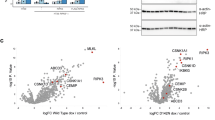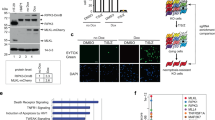Abstract
The RIPoptosome, composed of RIP1 and caspase-8, plays an important role in the regulation of apoptosis and necroptosis; however, the mechanism of complex formation by oligomerization and how the caspase-activating process and necroptosis are mediated by the formation of the RIPoptosome is not well-understood. This study revealed that the assembly mechanism of the RIPoptosome core is dependent on salt concentration and not on pH and time. In addition, we demonstrated that three RIP1 mutations, E626K, M637K, and S657K, have dominant negative effects. These dominant negative mutations in RIP1 may have potential applications in therapeutic intervention.





Similar content being viewed by others
References
Kerr JF, Wyllie AH, Currie AR (1972) Apoptosis: a basic biological phenomenon with wide-ranging implications in tissue kinetics. Br J Cancer 26:239–257
Evan GI, Vousden KH (2001) Proliferation, cell cycle and apoptosis in cancer. Nature 411:342–348
Feoktistova M, Geserick P, Panayotova-Dimitrova D, Leverkus M (2012) Pick your poison: the ripoptosome, a cell death platform regulating apoptosis and necroptosis. Cell Cycle 11:460–467
Nehs MA, Lin CI, Kozono DE, Whang EE, Cho NL, Zhu K, Moalem J, Moore FD, Jr. & Ruan DT (2011) Necroptosis is a novel mechanism of radiation-induced cell death in anaplastic thyroid and adrenocortical cancers. Surgery 150:1032–1039
Wrighton KH (2011) Cell death: a killer puts a stop on necroptosis. Nat Rev Mol Cell Biol 12:279
Wu W, Liu P, Li J (2012) Necroptosis: an emerging form of programmed cell death. Crit Rev Oncol Hematol 82:249–258
Christofferson DE, Yuan J (2010) Necroptosis as an alternative form of programmed cell death. Curr Opin Cell Biol 22:263–268
Cho YS, Challa S, Moquin D, Genga R, Ray TD, Guildford M, Chan FK (2009) Phosphorylation-driven assembly of the RIP1-RIP3 complex regulates programmed necrosis and virus-induced inflammation. Cell 137:1112–1123
Moquin D, Chan FK (2010) The molecular regulation of programmed necrotic cell injury. Trends Biochem Sci 35:434–441
Feoktistova M, Geserick P, Kellert B, Dimitrova DP, Langlais C, Hupe M, Cain K, MacFarlane M, Hacker G, Leverkus M (2011) cIAPs block ripoptosome formation, a RIP1/caspase-8 containing intracellular cell death complex differentially regulated by cFLIP isoforms. Mol Cell 43:449–463
Wang L, Du F, Wang X (2008) TNF-alpha induces two distinct caspase-8 activation pathways. Cell 133:693–703
He S, Wang L, Miao L, Wang T, Du F, Zhao L, Wang X (2009) Receptor interacting protein kinase-3 determines cellular necrotic response to TNF-alpha. Cell 137:1100–1111
Zhang H, Zhou X, McQuade T, Li J, Chan FK, Zhang J (2011) Functional complementation between FADD and RIP1 in embryos and lymphocytes. Nature 471:373–376
Park HH, Lo YC, Lin SC, Wang L, Yang JK, Wu H (2007) The death domain superfamily in intracellular signaling of apoptosis and inflammation. Ann Rev Immunol 25:561–586
Li J, McQuade T, Siemer AB, Napetschnig J, Moriwaki K, Hsiao YS, Damko E, Moquin D, Walz T, McDermott A, Chan FK, Wu H (2012) The RIP1/RIP3 necrosome forms a functional amyloid signaling complex required for programmed necrosis. Cell 150:339–350
Jang TH, Zheng C, Li J, Richards C, Hsiao YS, Walz T, Wu H, Park HH (2014) Structural study of the RIPoptosome core reveals a helical assembly for kinase recruitment. Biochemistry 53:5424–5431
Schwede T, Kopp J, Guex N, Peitsch MC (2003) SWISS-MODEL: an automated protein homology-modeling server. Nucleic Acids Res 31:3381–3385
Laskowski RA, Rullmannn JA, MacArthur MW, Kaptein R, Thornton JM (1996) AQUA and PROCHECK-NMR: programs for checking the quality of protein structures solved by NMR. J Biomol NMR 8:477–486
Jang TH, Zheng C, Wu H, Jeon JH, Park HH (2010) In vitro reconstitution of the interactions in the PIDDosome. Apoptosis 15:1444–1452
Park HH, Logette E, Rauser S, Cuenin S, Walz T, Tschopp J, Wu H (2007) Death domain assembly mechanism revealed by crystal structure of the oligomeric PIDDosome core complex. Cell 128:533–546
Wang L, Yang JK, Kabaleeswaran V, Rice AJ, Cruz AC, Park AY, Yin Q, Damko E, Jang SB, Raunser S, Robinson CV, Siegel RM, Walz T, Wu H (2010) The Fas-FADD death domain complex structure reveals the basis of DISC assembly and disease mutations. Nat Struct Mol Biol 17:1324–1329
Tinel A, Tschopp J (2004) The PIDDosome, a protein complex implicated in activation of caspase-2 in response to genotoxic stress. Science 304:843–846
Park HH (2011) Structural analyses of death domains and their interactions. Apoptosis 16:209–220
Acknowledgements
This research was supported by the Chung-Ang University Research Grant in 2018 and the Basic Science Research Program through the National Research Foundation (NRF) of Ministry of Education, Science and Technology (NRF-2017M3A9D8062960) and the Korea Healthcare Technology R&D project, Ministry of Health & Welfare (Grant No.: HI17C0155).
Author information
Authors and Affiliations
Corresponding author
Ethics declarations
Conflict of interest
The authors declare no competing financial and non-financial interests.
Ethical approval
The authors accepted principles of ethical standards.
Rights and permissions
About this article
Cite this article
Ha, H.J., Park, H.H. Identification and analysis of dominant negative mutants of RIP1 DD that disrupt RIPoptosome core formation. Mol Biol Rep 45, 1715–1722 (2018). https://doi.org/10.1007/s11033-018-4314-5
Received:
Accepted:
Published:
Issue Date:
DOI: https://doi.org/10.1007/s11033-018-4314-5




